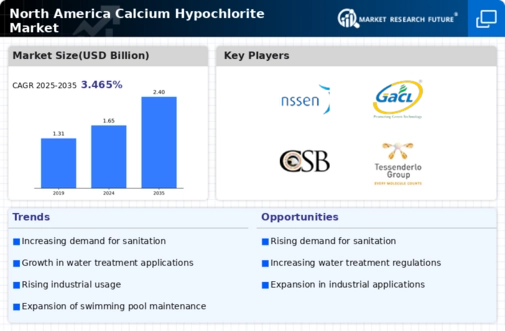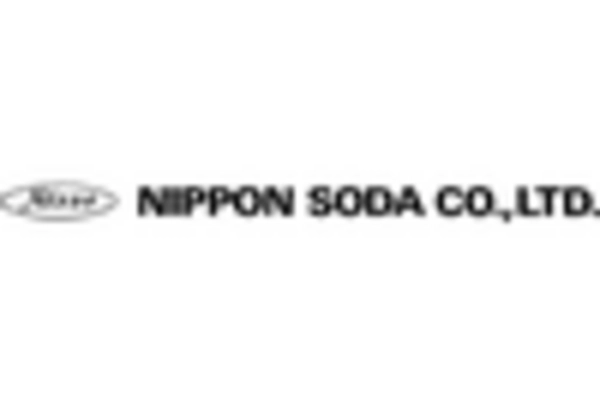Rising Agricultural Applications
The calcium hypochlorite market is witnessing a rise in agricultural applications, particularly in crop protection and irrigation systems. Farmers are increasingly utilizing calcium hypochlorite for its antimicrobial properties, which help in controlling pathogens in irrigation water and enhancing crop yield. Recent studies suggest that the use of calcium hypochlorite in agriculture can improve water quality and reduce disease incidence in crops, leading to higher productivity. As the agricultural sector in North America continues to evolve, the demand for effective and safe agricultural chemicals, including calcium hypochlorite, is expected to grow, potentially increasing its market share significantly.
Increasing Focus on Public Health
The calcium hypochlorite market is experiencing a notable surge in demand due to heightened awareness surrounding public health and sanitation. As municipalities and private entities prioritize clean water supply, the need for effective disinfectants has escalated. Calcium hypochlorite, recognized for its efficacy in water treatment, is increasingly utilized in municipal water systems across North America. Recent data indicates that the market for water treatment chemicals, including calcium hypochlorite, is projected to grow at a CAGR of approximately 5.2% through 2026. This growth is driven by the necessity to ensure safe drinking water, particularly in urban areas where population density poses challenges for water quality management.
Expansion of Swimming Pool Industry
The calcium hypochlorite market is significantly influenced by the expansion of the swimming pool sector in North America. With a growing number of residential and commercial swimming pools, the demand for effective pool sanitization solutions has intensified. Calcium hypochlorite is favored for its ability to maintain water clarity and safety, making it a staple in pool maintenance. According to industry reports, the North American swimming pool market is expected to reach $5 billion by 2027, with a substantial portion of this growth attributed to the increasing adoption of calcium hypochlorite for disinfection purposes. This trend underscores the importance of calcium hypochlorite in ensuring safe recreational water environments.
Environmental Regulations and Compliance
The calcium hypochlorite market is significantly impacted by stringent environmental regulations aimed at ensuring safe chemical usage and waste management. Regulatory bodies in North America are enforcing guidelines that necessitate the use of effective disinfectants in various applications, including water treatment and sanitation. Compliance with these regulations often requires the adoption of calcium hypochlorite due to its proven effectiveness and relatively lower environmental impact compared to alternative chemicals. As regulatory frameworks continue to evolve, the demand for compliant and effective disinfectants is likely to drive growth in the calcium hypochlorite market, positioning it as a preferred choice among industries seeking to meet environmental standards.
Technological Advancements in Chemical Production
The calcium hypochlorite market is benefiting from technological advancements in chemical production processes. Innovations aimed at enhancing production efficiency and reducing costs are becoming increasingly prevalent. For instance, the introduction of more efficient chlorination methods has the potential to lower production costs by up to 15%, thereby making calcium hypochlorite more accessible to various sectors, including water treatment and agriculture. As production techniques evolve, the market is likely to see a shift in pricing dynamics, which could further stimulate demand across North America. This trend indicates a promising future for calcium hypochlorite as a key player in the chemical industry.


















Leave a Comment